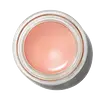What's inside
What's inside
 Key Ingredients
Key Ingredients

 Benefits
Benefits

 Concerns
Concerns

 Ingredients Side-by-side
Ingredients Side-by-side

Isododecane
EmollientDimethicone
EmollientDisteardimonium Hectorite
StabilisingSynthetic Fluorphlogopite
Trimethylsiloxysilicate
EmollientVp/Eicosene Copolymer
Brassica Campestris Seed Oil
Skin ConditioningSilica
AbrasiveDimethicone/Vinyl Dimethicone Crosspolymer
Skin ConditioningPropylene Carbonate
SolventButyrospermum Parkii Butter
Skin ConditioningSilica Dimethyl Silylate
EmollientTriethoxycaprylylsilane
Tabebuia Impetiginosa Bark Extract
Skin ConditioningPolyglyceryl-3 Diisostearate
EmulsifyingTocopheryl Acetate
AntioxidantCI 77891
Cosmetic ColorantIron Oxides
CI 77007
Cosmetic ColorantIsododecane, Dimethicone, Disteardimonium Hectorite, Synthetic Fluorphlogopite, Trimethylsiloxysilicate, Vp/Eicosene Copolymer, Brassica Campestris Seed Oil, Silica, Dimethicone/Vinyl Dimethicone Crosspolymer, Propylene Carbonate, Butyrospermum Parkii Butter, Silica Dimethyl Silylate, Triethoxycaprylylsilane, Tabebuia Impetiginosa Bark Extract, Polyglyceryl-3 Diisostearate, Tocopheryl Acetate, CI 77891, Iron Oxides, CI 77007
Isododecane
EmollientCalcium Sodium Borosilicate
Dimethicone
EmollientPolyethylene
AbrasiveHydrogenated Polyisobutene
EmollientQuaternium-90 Bentonite
Dimethicone Silylate
Silica
AbrasiveOctyldodecanol
EmollientTocopheryl Acetate
AntioxidantLecithin
EmollientTrihydroxystearin
Skin ConditioningCopernicia Cerifera Wax
Propylene Carbonate
SolventTriethoxycaprylylsilane
Tin Oxide
AbrasiveCalcium Aluminum Borosilicate
Pentaerythrityl Tetra-Di-T-Butyl Hydroxyhydrocinnamate
AntioxidantMica
Cosmetic ColorantCI 77891
Cosmetic ColorantIron Oxides
CI 77000
Cosmetic ColorantCI 77163
Cosmetic ColorantCI 42090
Cosmetic ColorantCI 77400
Cosmetic ColorantCI 75470
Cosmetic ColorantCI 77289
Cosmetic ColorantCI 77288
Cosmetic ColorantCI 77510
Cosmetic ColorantCI 77742
Cosmetic ColorantCI 77007
Cosmetic ColorantCI 19140
Cosmetic ColorantIsododecane, Calcium Sodium Borosilicate, Dimethicone, Polyethylene, Hydrogenated Polyisobutene, Quaternium-90 Bentonite, Dimethicone Silylate, Silica, Octyldodecanol, Tocopheryl Acetate, Lecithin, Trihydroxystearin, Copernicia Cerifera Wax, Propylene Carbonate, Triethoxycaprylylsilane, Tin Oxide, Calcium Aluminum Borosilicate, Pentaerythrityl Tetra-Di-T-Butyl Hydroxyhydrocinnamate, Mica, CI 77891, Iron Oxides, CI 77000, CI 77163, CI 42090, CI 77400, CI 75470, CI 77289, CI 77288, CI 77510, CI 77742, CI 77007, CI 19140
Ingredients Explained
These ingredients are found in both products.
Ingredients higher up in an ingredient list are typically present in a larger amount.
This pigment is called Ultramarine blue lazurite. It gives a saturated blue color, but can be used to create other colors as well.
According to the manufacturer, it is usually made from kaolin, sodium sulfate, sodium carbonate, sulfur, and charcoal.
Ci 77891 is a white pigment from Titanium dioxide. It is naturally found in minerals such as rutile and ilmenite.
It's main function is to add a white color to cosmetics. It can also be mixed with other colors to create different shades.
Ci 77891 is commonly found in sunscreens due to its ability to block UV rays.
Learn more about CI 77891Dimethicone is a type of synthetic silicone created from natural materials such as quartz.
What it does:
Dimethicone comes in different viscosities:
Depending on the viscosity, dimethicone has different properties.
Ingredients lists don't always show which type is used, so we recommend reaching out to the brand if you have questions about the viscosity.
This ingredient is unlikely to cause irritation because it does not get absorbed into skin. However, people with silicone allergies should be careful about using this ingredient.
Note: Dimethicone may contribute to pilling. This is because it is not oil or water soluble, so pilling may occur when layered with products. When mixed with heavy oils in a formula, the outcome is also quite greasy.
Learn more about DimethiconeIsododecane is a fragrance, emollient, and solvent.
As an emollient, it helps your skin stay soft and hydrated. Emollients help trap moisture into your skin.
Isododecane's role as a solvent makes it a great texture enhancer. It spreads smoothly on skin and does not leave a sticky feeling behind. Isododecane also helps prevent color transfer in makeup products.
Isododecane is not absorbed into skin.
Learn more about IsododecaneThis ingredient is a solvent. It helps dissolve active ingredients and alter the texture of products.
Propylene Carbonate is commonly used in makeup and with clay, such as montmorillonite or bentonite.
Studies show this ingredient to be safe for cosmetics. When it is undiluted, it can cause skin irritation. (It is always diluted in skincare and makeup). This ingredient is water-soluble.
Propylene Carbonate is created from propylene glycol and carbonic acid.
Learn more about Propylene CarbonateSilica, also known as silicon dioxide, is a naturally occurring mineral. It is used as a fine, spherical, and porous powder in cosmetics.
Though it has exfoliant properties, the function of silica varies depending on the product.
The unique structure of silica enhances the spreadability and adds smoothness, making it a great texture enhancer.
It is also used as an active carrier, emulsifier, and mattifier due to its ability to absorb excess oil.
In some products, tiny microneedles called spicules are made from silica or hydrolyzed sponge. When you rub them in, they lightly polish away dead skin layers and enhance the penetration of active ingredients.
Learn more about SilicaTocopheryl Acetate is AKA Vitamin E. It is an antioxidant and protects your skin from free radicals. Free radicals damage the skin by breaking down collagen.
One study found using Tocopheryl Acetate with Vitamin C decreased the number of sunburned cells.
Tocopheryl Acetate is commonly found in both skincare and dietary supplements.
Learn more about Tocopheryl AcetateTriethoxycaprylylsilane is a silicone used to bind and stabilize ingredients.
As an emulsifier, it helps prevent ingredients from separating. This can help elongate the shelf life of products.
Triethoxycaprylylsilane is often used to coat mineral sunscreens ingredients to help give a better feel. It also helps reduce oxidative stress in sunscreens.
Learn more about TriethoxycaprylylsilaneThis ingredient is a combination of red, black, and yellow iron oxide pigments. This combination of colors is usually found in foundation, because it results in a "skin" color.